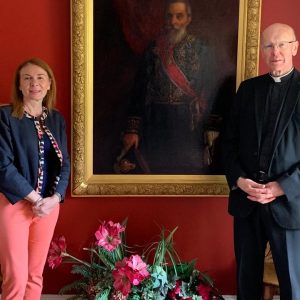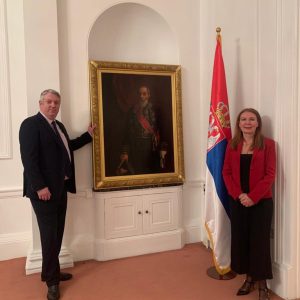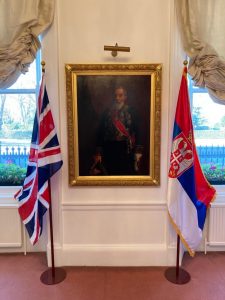Čedomilj Mijatović occupies a special place in the history of Serbian-English cultural and diplomatic ties

There are very few brilliant careers with such a stellar rise in a person’s youth, such as that of Čedomilj Mijatović (1842-1932). The breadth of his interests, diverse roles and the indelible mark he left in each of them are the main characteristics of his productive life. It is difficult to define in which area he left the strongest impression, but his unequivocal view of the West and the support and promotion of Serbia are certainly among the most important directions of his life.
Mijatović’s life in Serbia was also marked by his political work in two segments – foreign affairs and economics. He started his career as a professor of politics, economics and finance at the Belgrade-based Velika Škola (the Higher School). At a later date, he was Foreign Minister on three separate occasions and Finance Minister six times. Mijatović was also one of the founders of the Progressive Party, which was close to the then prince and later king Milan Obrenović. He was a diplomat for more than 30 years. King Milan called him a Victorian among Serbs and a Byzantine diplomat.
He is credited with building institutions and modernizing Serbia. Mijatović also participated in the implementation of the project that entailed building the Belgrade-Niš railway, which was rife with corruption scandals, but he emerged incorruptible and untainted.
He is one of the founders of the National Bank of Serbia. His bust is still at the entrance to the ceremonial hall of the NBS, while the hall itself is adorned with a framed founding document with Mijatović’s signature. Economists also remember him for the introduction of the metric system and the dinar as the national currency.
Čedomilj Mijatović is one of the first 16 academics of the Serbian Royal Academy and its second president.
In terms of foreign policy, he took part in the biggest peace conference in Bucharest after the Serbian-Bulgarian war of 1885. It was the shortest peace agreement ever signed, containing just one sentence – “Peace is re-established between Serbia and Bulgaria”. Thanks to Mijatović, Serbia did not have to pay 25 million francs to Bulgaria in war reparations.
Čedomilj Mijatović is one of the first 16 academics of the Serbian Royal Academy and its second president
Despite pressure, Mijatović managed to end the war without territorial encroachments and war reparations. History remembers him as a signatory to a secret convention with Austro-Hungarian Empire, which is why some considered him a traitor. He did admit that he made several mistakes in his life, but that he did not view signing the secret convention as one of them. Following the signing, Serbia undertook not to have any claims against Bosnia and Herzegovina and not to conclude agreements with other countries without the approval of Austro-Hungarian authorities. The context of this signature was of great importance considering that 90% of the then Serbia’s export was closely tied to Austria-Hungary, an empire that imposed economic sanctions on Serbia as many as 30 times during the 19th century and had elaborate plans for its occupation at that time. Geostrategically speaking, this was also Serbia’s clear deviation from the East, i.e. Russia, and its getting closer to the West.
 Although educated in the German-speaking area – in Munich, Leipzig, Zurich and Vienna – he was one of the greatest Serbian Anglophiles. Together with his wife Elodie Lawton, an Englishwoman, he laid the foundation for the presentation of Serbian history in the UK. “The first Serbian historian”, it is written about Elodie on the plaque on the house in Knez Miloš Street in Belgrade where they lived. She wrote “The History of Modern Serbia” in English, which broadened the knowledge that the British people had of Serbia. Elodie also tried to translate the Kosovo Epic, a translation that was the most important testimony to this historical period and folk songs in the UK for over 30 years.
Although educated in the German-speaking area – in Munich, Leipzig, Zurich and Vienna – he was one of the greatest Serbian Anglophiles. Together with his wife Elodie Lawton, an Englishwoman, he laid the foundation for the presentation of Serbian history in the UK. “The first Serbian historian”, it is written about Elodie on the plaque on the house in Knez Miloš Street in Belgrade where they lived. She wrote “The History of Modern Serbia” in English, which broadened the knowledge that the British people had of Serbia. Elodie also tried to translate the Kosovo Epic, a translation that was the most important testimony to this historical period and folk songs in the UK for over 30 years.
Since 1889, Čedomilj Mijatović lived and worked in Great Britain, of which three times as an envoy to the St James Court. He said that he knew England better than Serbia. He wrote and translated from English, was a journalist and wrote articles about economics.
“Čedomilj Mijatović occupies a special place in the history of Serbian-English cultural and diplomatic ties. He had a more prominent role than any previous person engaged in these activities,” wrote the historian Slobodan G. Marković, the writer of the only biography of Čedomilj Mijatović, in one of his texts.
He was the most quoted Serb in the London Times. His every step was carefully observed in London. He was the epitome of a real connection between not only Serbia but the entire Balkans and the UK. “About Serbs and Serbia” is the title of one of his historical books in the English language. Mijatović’s contributions were also published in the Encyclopedia Britannica. In this prestigious edition, he was the author of all the determinants about Serbia. Historian Čedomir Antić believes that, except for Pupin, we have not had a more influential Serb in the world. He was also the first Serb to be elected a member of the Royal Historical Society in London.
Although educated in the German-speaking area – in Munich, Leipzig, Zurich and Vienna – he was one of the greatest Serbian Anglophiles
After the assassination of King Aleksandar Obrenović and Queen Draga in 1903, he strongly condemned this event and resigned as a Serbian emissary in London. He complained at the time that the UK would not take him and that they called him ‘a so-called emissary’. He demanded that the conspirators who committed the murder be punished. Britain and the Netherlands have severed diplomatic relations with Serbia on this occasion. As a private person, he worked on the re-establishment of diplomatic relations between Serbia and the United Kingdom, in which he succeeded in 1906.
As a great Orthodox believer, in 1914, King Petar I and Prime Minister Pašić offered him the position of the head of the Serbian Church, namely the first patriarch of the renewed Serbian Church. He did not succumb to the temptation and declined the offer.
During the First World War, he led a diplomatic and humanitarian mission to collect aid for Serbia and the Serbian people. On the same mission, he travels with suffragettes across America and Canada, introducing thousands of listeners to Serbia and its suffering.
In addition to relations with the UK, Mijatović greatly contributed to the development of relations with the United States. He signed the trade agreement with the U.S. in 1881 which is considered the establishment of diplomatic relations between Belgrade and Washington.
 ABOUT THE PORTRAIT
ABOUT THE PORTRAIT
The Embassy of the Republic of Serbia in London has recently received a magnificent portrait of Čedomilj Mijatović, as one of the few surviving testimonies from his life that has survived the ravages of time.
The portrait was in the possession of Michael Tavenor, the Dean of the cathedral in Hereford, for decades. He received the painting from Čedomilj Mijatović’s daughter, Milica Prior, whom he had with his second wife Ada Prior. She lived modestly in the suburbs of London and occasionally received help from a priest at the local Anglican Church in Ealing, Michael Tavenor. In return, she gave him a portrait of her father in 1912, which he then sent to be restored. After retiring, he decided to sell the portrait, and he wanted the painting to end up in Serbia.
As part of a wider concern for Serbia’s historical heritage, which is one of the priorities of the Serbian Ministry of Foreign Affairs and the Serbian diplomatic worldwide network, I considered it historically important to buy the painting, for the painting to become the property of the Republic of Serbia and to keep it on display at the Embassy. I turned to a prominent British lawyer of Serbian origin, Petar Orlić, for help, who bought the portrait and donated it to the Embassy of the Republic of Serbia in London, for which I am sincerely grateful.
The portrait is almost life-size and is the work of the Indian artist Dzehangir Ardesir Lalkaka (1884-1967), who was very popular in Indian aristocratic circles. His portrait of King George V from 1929 still hangs in the Buckingham Palace today.
The urn with Čedomilj Mijatović’s ashes (who died in 1932) ended up in the Embassy of the Kingdom of Yugoslavia in London during the Second World War, but was subsequently lost. Mijatović’s very valuable archive also burned down in a fire in London before the First World War.
The portrait’s return was an occasion to pay homage to his character and work. Čedomilj Mijatović is back among the Serbs again.